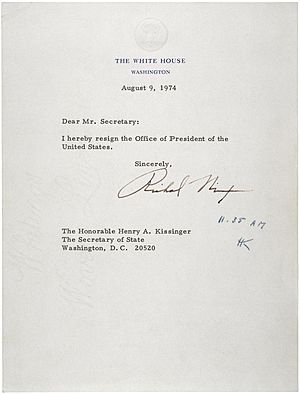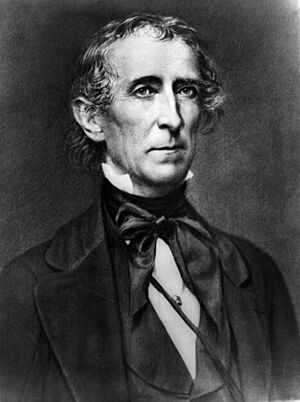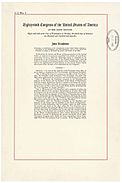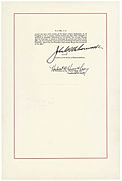Twenty-fifth Amendment to the United States Constitution facts for kids
The Twenty-fifth Amendment (also called Amendment XXV) is a part of the United States Constitution. It explains what happens if the President can no longer do their job. This could be for a short time, like if the President is sick or disabled. Or it could be permanent, if the President dies, resigns, or is removed from office.
The Twenty-fifth Amendment also explains what happens if there is no Vice President. And it sets rules for who takes over if both the President and Vice President cannot do their jobs at the same time.
The United States Congress officially approved this Amendment on February 10, 1967.
Contents
- Why the 25th Amendment Was Needed
- How the Amendment Was Approved
- The Official Text of the 25th Amendment
- How the 25th Amendment Works
- How the 25th Amendment Has Been Used
- Images for kids
- See also
Why the 25th Amendment Was Needed
The original Constitution had some rules about what happens if the President can't do their job. Article Two, Section 1, Clause 6 said that if the President was removed, died, resigned, or became unable to do their duties, the Vice President would take over. It also said Congress could decide who would act as President if both the President and Vice President were unable to serve.
However, this part of the Constitution was not very clear. It didn't say:
- Who decides if a President is unable to do their job.
- If the Vice President would actually become the President or just an "Acting President."
- What happens if the Vice President's job becomes empty.
- How Congress should choose someone if both the President and Vice President couldn't serve.
Past Problems with Presidential Succession
Because the Constitution was unclear, there were problems when presidents died or became ill.
In 1841, President William Henry Harrison died in office. His Vice President, John Tyler, insisted that he was now the President, not just an "Acting President." He took the Presidential Oath and moved into the White House. No one officially challenged him. Congress eventually agreed that Tyler was the tenth President. This set a rule, called the "Tyler Precedent," meaning the Vice President would become the full President if the President died.
Other times, presidents became sick but stayed in office. For example, President Woodrow Wilson had a stroke. But his wife, Edith Bolling Wilson, and his doctor kept it a secret. So, no one took over, even though Wilson couldn't do his job well.
Also, before the 25th Amendment, the Vice President's job was empty 18 times. This happened when Vice Presidents died, resigned, or became President. For example, there was no Vice President for almost four years after President Franklin D. Roosevelt died. These issues showed that clearer rules were needed.
The Kennedy Assassination and New Rules
On November 22, 1963, President John F. Kennedy was murdered. This event made it very clear to Congress that they needed to fix the rules for presidential succession quickly. The United States was in the middle of the Cold War, and the new President, Lyndon B. Johnson, had once had a heart attack. The next person in line, the Speaker of the House, John W. McCormack, was 71 years old. This urgent situation pushed Congress to act faster.
Ideas for a New Amendment

Members of Congress suggested different ideas to add details to the Constitution's rules.
One idea, the Keating–Kefauver Proposal, suggested letting Congress make a law about when a President is unable to serve. But some lawmakers worried Congress might misuse this power.
The Bayh–Celler Proposal eventually became the Twenty-fifth Amendment. It was proposed in 1965 by Senator Birch Bayh and Representative Emanuel Celler. This proposal was different because it suggested a way to fill the Vice President's job if it was empty. It also set clear rules for how a President could be declared unable to do their job.
The Senate passed their version of the amendment in February 1965. The House passed a different version in April. So, committees from both groups had to work together to create one version everyone could agree on.
How the Amendment Was Approved
For the Twenty-fifth Amendment to become part of the Constitution, three-fourths of the state legislatures (38 out of 50 states) had to approve it. It took almost two years for 38 states to ratify the Amendment. After it was added, nine more states approved it. Three states never did.
Here is the order in which the states approved the Amendment:
| Order | State | Date | Order | State | Date | |
|---|---|---|---|---|---|---|
| 1 | Nebraska | July 12, 1965 | 2 | Wisconsin | July 13, 1965 | |
| 3 | Oklahoma | July 16, 1965 | 4 | Massachusetts | August 9, 1965 | |
| 5 | Pennsylvania | August 18, 1965 | 6 | Kentucky | September 15, 1965 | |
| 7 | Arizona | September 22, 1965 | 8 | Michigan | October 5, 1965 | |
| 9 | Indiana | October 20, 1965 | 10 | California | October 21, 1965 | |
| 11 | Arkansas | November 4, 1965 | 12 | New Jersey | November 29, 1965 | |
| 13 | Delaware | December 7, 1965 | 14 | Utah | January 17, 1966 | |
| 15 | West Virginia | January 20, 1966 | 16 | Maine | January 24, 1966 | |
| 17 | Rhode Island | January 28, 1966 | 18 | Colorado | February 3, 1966 | |
| 19 | New Mexico | February 3, 1966 | 20 | Kansas | February 8, 1966 | |
| 21 | Vermont | February 10, 1966 | 22 | Alaska | February 18, 1966 | |
| 23 | Idaho | March 2, 1966 | 24 | Hawaii | March 3, 1966 | |
| 25 | Virginia | March 8, 1966 | 26 | Mississippi | March 10, 1966 | |
| 27 | New York | March 14, 1966 | 28 | Maryland | March 23, 1966 | |
| 29 | Missouri | March 30, 1966 | 30 | New Hampshire | June 13, 1966 | |
| 31 | Louisiana | July 5, 1966 | 32 | Tennessee | January 12, 1967 | |
| 33 | Wyoming | January 25, 1967 | 34 | Washington | January 26, 1967 | |
| 35 | Iowa | January 26, 1967 | 36 | Oregon | February 2, 1967 | |
| 37 | Minnesota | February 10, 1967 | 38 | Nevada | February 10, 1967 | |
| Amendment added to Constitution: February 10, 1967 | ||||||
| 39 | Connecticut | February 14, 1967 | 40 | Montana | February 15, 1967 | |
| 41 | South Dakota | March 6, 1967 | 42 | Ohio | March 7, 1967 | |
| 43 | Alabama | March 14, 1967 | 44 | North Carolina | March 22, 1967 | |
| 45 | Illinois | March 22, 1967 | 46 | Texas | April 25, 1967 | |
| 47 | Florida | May 25, 1967 | ||||
| Never ratified the Amendment | ||||||
| North Dakota | Georgia | |||||
| South Carolina | ||||||
The Official Text of the 25th Amendment
Here is what the Twenty-fifth Amendment officially says:
Section 1. If the President is removed from office, dies, or resigns, the Vice President will become President.
Section 2. If the Vice President's job is empty, the President will choose a new Vice President. This person will become Vice President if a majority of both the Senate and the House of Representatives agree.
Section 3. If the President writes a letter to the President pro tempore of the Senate and the Speaker of the House of Representatives saying they cannot do their job, the Vice President will become Acting President. The President can take back their job by sending another letter saying they are ready to return.
Section 4. If the Vice President and a majority of the main leaders of the executive departments (the Cabinet) or another group chosen by Congress write a letter saying the President cannot do their job, the Vice President will immediately become Acting President.
If the President then sends a letter saying they are able to do their job again, they will get their powers back. However, if the Vice President and the majority of the Cabinet (or other group) send another letter within four days saying the President is still unable, then Congress must decide. Congress must meet within 48 hours if they are not already in session. If two-thirds of both the House and Senate vote within 21 days that the President is still unable to do their job, the Vice President will continue as Acting President. If Congress does not vote this way, or does not vote within 21 days, the President gets their job back.
How the 25th Amendment Works
The Twenty-fifth Amendment has four main parts, called sections, that explain different situations.
Section 1: Presidential Succession
Section 1 made the "Tyler Precedent" an official law. It clearly states that if a President is removed from office, dies, or resigns, the Vice President immediately becomes the full President. They are not just an "Acting President."
Section 2: Filling a Vice Presidential Vacancy
Before this Amendment, if the Vice President's job became empty, it would stay empty until the next election.
Under Section 2, if there is no Vice President, the President can choose someone to fill the job. That person becomes Vice President if most members of both the House and Senate agree.
Section 3: When the President Steps Aside Temporarily
Section 3 allows a President to temporarily give their powers to the Vice President. The President must send a written letter to the leaders of the Senate and the House of Representatives saying they are unable to do their job. Once this happens, the Vice President becomes Acting President. The President can take back their powers at any time by sending another letter saying they are ready to return.
Section 4: When Others Declare the President Unable
Section 4 is the only part of the Amendment that has never been officially used. It allows other government officials to declare the President unable to do their job. This can only happen if the Vice President agrees. Also, a majority of the main leaders of the President's Cabinet (or another group chosen by Congress) must agree.
To do this, they would sign and send a letter to the leaders of the Senate and the House. The Vice President would then become the Acting President.
If the President later sends a letter saying they are able to return, they can get their job back. But if the Vice President and the Cabinet still think the President is unable, they can challenge the President's return. They have four days to send another letter saying the President is still unable. Then, Congress must meet quickly (within 48 hours if not already in session). Congress then has 21 days to make a decision. During this time, the Vice President remains Acting President.
If two-thirds of both the House and Senate vote that the President is still unable to do their job, the Vice President continues as Acting President. If Congress does not vote this way, or if they don't vote within 21 days, the President gets their job back.
How the 25th Amendment Has Been Used
The Twenty-fifth Amendment has been used six times since it was approved. Section 1 has been used once, Section 2 twice, and Section 3 three times. Section 4 has never been used, though it was thought about twice.
Using Section 1: Presidential Change

President Richard Nixon resigned on August 9, 1974. This happened before the House of Representatives could vote on whether to remove him from office due to the Watergate scandal. As soon as Nixon resigned, Vice President Gerald Ford immediately became President, as Section 1 states.
Using Section 2: Filling the Vice President's Job
Before the 25th Amendment, if the Vice President's job was empty, it stayed empty until the next election.
On October 10, 1973, Vice President Spiro Agnew resigned. Two days later, President Richard Nixon chose Gerald Ford to be the new Vice President. According to Section 2, most members of both the House and Senate had to approve Ford. By December 6, 1973, both houses of Congress had approved him. Ford was sworn in as Vice President. Gerald Ford is the only person in U.S. history to become Vice President and then President without being elected to either job.
When Gerald Ford became President after Nixon resigned, the Vice President's job became empty again. On August 20, 1974, President Ford chose Nelson Rockefeller to be the new Vice President. Congress approved Rockefeller in December 1974, and he was sworn in.
Using Section 3: President Temporarily Steps Aside
Presidents have used Section 3 three times. Each time, they temporarily gave power to their Vice Presidents because they needed to have medical tests or surgery that required anesthesia.
George H. W. Bush (1985)
On July 12, 1985, President Ronald Reagan found out he needed surgery for a growth in his colon. He decided to have the surgery right away.
Reagan did not want to officially use Section 3 of the 25th Amendment. He was worried it might set a bad precedent for future presidents. However, his lawyers and staff suggested he use it.
Reagan signed a letter that was delivered to the leaders of the Senate and the House. In the letter, he said he knew about Section 3 but didn't think it fully applied to his situation. Still, he wanted Vice President George H. W. Bush to take over during his surgery. Many people believe Reagan intended to use Section 3, even if he didn't say it directly.
Dick Cheney (2002; 2007)
On June 29, 2002, President George W. Bush became the first President to officially use Section 3. He needed a colonoscopy, a test of the colon, and would be given anesthesia. He formally gave power to his Vice President, Dick Cheney, following the rules of the 25th Amendment. Unlike Reagan, he specifically stated he was using Section 3 in his letter. After about two hours, Bush was awake and took back the Presidency.
On July 21, 2007, President Bush again used Section 3 for another colonoscopy. Again, Cheney was Acting President for about two hours until Bush was ready to take back the Presidency.
Considering Section 4: When Others Might Step In
Twice, President Ronald Reagan's staff thought about using Section 4 of the 25th Amendment to declare him unable to do his job.
1981: Reagan Assassination Attempt
On March 30, 1981, a man tried to kill President Ronald Reagan. Reagan was shot and needed surgery. He couldn't use Section 3 to give power to his Vice President. Vice President George H.W. Bush was on an airplane returning from Texas and couldn't use Section 4 right away. Reagan was out of surgery by the time Bush arrived in Washington, D.C..
Later, Birch Bayh, who helped write the 25th Amendment, said that Section 4 should have been used during this time.
1987: Concerns About Reagan's Performance
In 1987, Reagan's Chief of Staff, Donald Regan, resigned. Howard Baker took his place. Regan's staff told Baker that Reagan seemed distracted and not fully engaged in his duties. They suggested Baker be ready to use Section 4 of the 25th Amendment to remove Reagan's duties.
However, when Baker and his new team met with President Reagan, they found him to be fully in command. They realized he was perfectly capable of doing his job.
Images for kids
-
(L–R): President Richard Nixon, First Lady Pat Nixon, Betty Ford and Gerald Ford, after President Nixon nominated Gerald Ford to be Vice President(The White House, October 13, 1973)
See also
 In Spanish: Vigesimoquinta Enmienda a la Constitución de los Estados Unidos para niños
In Spanish: Vigesimoquinta Enmienda a la Constitución de los Estados Unidos para niños





